2019 Q1 Review - A Sharp Decline in Market Volatility Following an Explosive Q4 by Josh Olszewicz

The sharp decline in volatility also led to a substantial drop in exchange volumes. However, the total crypto market cap (shown below) made several higher lows this quarter, gaining about 25% from the lows in early February, while coiling towards horizontal resistance at US$150 billion.

Additionally, most of the high market cap coins have been highly correlated over the past month, with Binance Coin (BNB) showing the lowest correlation (shown below).
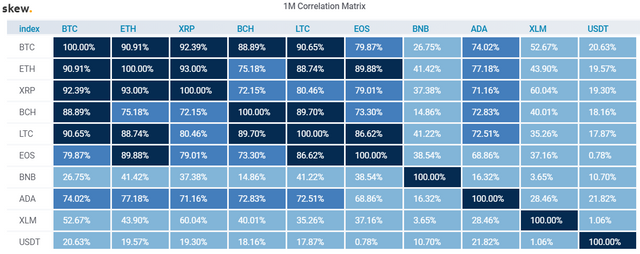
Source: https://www.sk3w.co/correlation_spread
Binance revolution
As the best performing high cap cryptocurrency during Q1, BNB gained more than 200% this quarter (green line, chart below), and currently holds a market cap of US$2.687 billion. Since launching in September 2017, the Binance exchange has risen to become a behemoth amongst trading platforms. Daily trading volumes have eclipsed most competitors in the space, and Binance has quickly achieved "unicorn" status with a valuation north of US$1 billion. According to Binance founder and CEO Changpeng Zhao, many Binance employees get 100% of their compensation in BNB.
While BNB is currently an ERC-20 token, the asset will eventually migrate to a native coin on Binance Chain and Zhao is encouraging other asset developers to migrate to the new chain.
Currently, the BNB token offers traders a discount on the Binance platform trading fees. Trading fee profits earned by Binance are also redistributed to BNB holders in the form of a BNB token burn. Binance users with more than 500 BNB also receive twice the standard commission for account referrals.
In the future, the BNB token and Binance Chain will likely act as a gatekeeper for access to the Binance ecosystem. The current constituent features include; exchange listings and Initial Exchange Offerings on Binance Launchpad, the decentralized exchange, and margin trading.
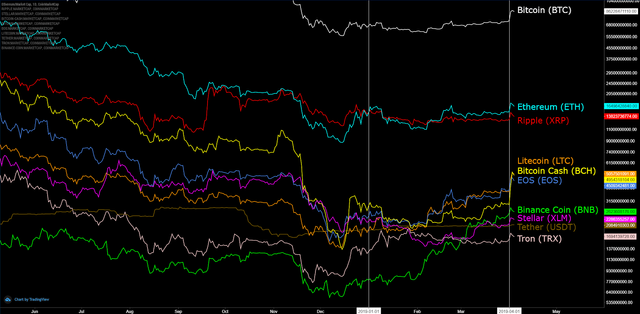
Bitcoin drawn and quartered
Throughout most of its lifecycle, relative Bitcoin (BTC) changes in price have been closely related to three-month cycles. These quarterly cycles often see a dramatic expansion or contraction in price, with very few quarters ending with less than a 10% price change. Historically, Q2 and Q4 of any given year have seen the most positive periods while Q1 and Q3 have seen the most negative periods.
In total, there have been 21 positive quarters and 12 negative quarters. The highest positive period was Q2 2011. The average gain among all positive periods, excluding Q2 2011, is 126%, while the average loss among all negative periods is 28%. The longest period of consecutive gains occurred between Q4 2016 and Q1 2018, totaling 484%. The longest period of consecutive losses occurred between Q3 2014 and Q2 2015, totaling 80%.
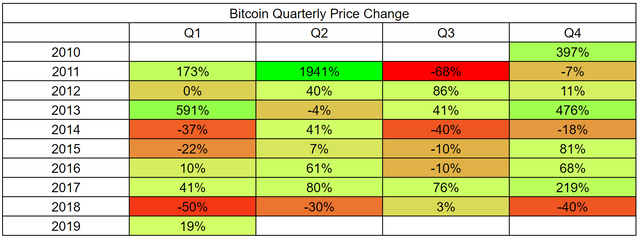
Furthermore, the opening and expiration dates of the Chicago Mercantile Exchange (CME) BTC cash-settled futures contracts, launched in December 2017, have had a significant impact on price. The CME facilitates trades for the largest portion of derivatives contracts in the world. At the end of February 2019, the CME saw the highest volume ever in a single day for the BTC futures product. Additionally, volatility increased dramatically after the most recent quarterly contract rollover earlier this week.
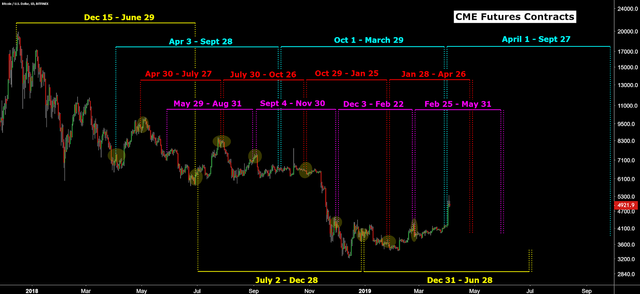
DeFi takes the torch
As ICOs and crowd sales have faded in terms of both quantity and size, the Decentralized Finance movement, or DeFi, has increasingly gained in popularity. Q1 2019 saw a significant drop in ICO treasury withdrawals when compared to Q4 2018. Treasury withdrawals had a significant impact on Ethereum (ETH) price in the last quarter of 2018.
According to Coinschedule.com, just 16 token sales started and 51 token sales ended during the past three months, raising a total of US$481 million. In comparison, Q1 2018 saw token sale raises exceed US$8.44 billion.

Source: https://diar.co/ethereum-ico-treasury-balances/
The current jewel in the DeFi crown is Maker (MKR), an ERC-20 token which uses a Decentralized Autonomous Organization (DAO) to create Collateralized Debt Positions (CDPs). Currently, only ETH can be used as collateral. These CDPs issue Dai (DAI), a stablecoin with a soft peg to the U.S. dollar, through autonomous feedback mechanisms, and incentivized external actors.
As the use of Dai has risen in popularity, the US$1 peg has drifted lower, prompting several stability fee adjustments throughout Q1 2019, resulting in a fee increase to 7.5%. Despite rising usage fees, the Maker DAO has continued to absorb additional Ethereum, and now holds just over 2% (shown below) of the circulating supply, or US$347 million.

Source: https://mkr.tools/system
Another component of the DeFi ecosystem is Bitcoin's Lightning Network (LN) which has quickly increased in popularity since going live on March 15th, 2018. The LN facilitates trusted, bidirectional, off-chain, hub and spoke payment channels at little to no cost and acts as a vehicle for instant payments, micro, and nano-transactions, while offering increased network scalability. Transactions sizes are currently capped at ~0.04BTC while the network is being developed and built. There are now almost 44,000 available channels, with a total channel value of 1092 BTC, or US$5.3 million currently (shown below).
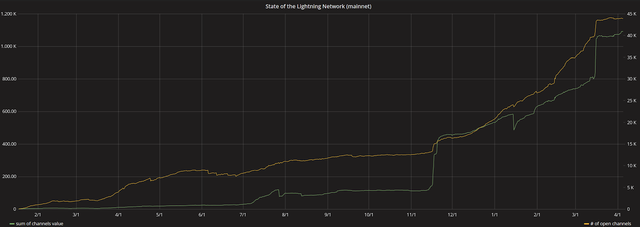
Source: https://p2sh.info/dashboard/db/lightning-network
In early Q1, a community member named Hodlonaut started an experiment to send payments through the LN, which has become known as the LN Trust Chain. A random stranger was initially sent 100,000 satoshis and the transaction has now been relayed to over 250 unique users in 39 countries. The experiment has acted as a catalyst for increased public awareness of the LN.
Three services built on the LN have also quickly gained popularity. Lightning Spin, a gambling roulette game, accrued over 10,000 invoices in a 10-month span and was sold to another party in late March, becoming the first LN app to trade hands. Tippin.Me, a tipping service similar to the previous on-chain version ChangeTip, allows users to send microtransactions on the LN with a few clicks. The service became so popular so quickly that it initially encountered server trouble trying to keep up with demand. Ln.pizza also went live this quarter, which allows U.S. users to instantly purchase Domino's pizza through the LN, with a 5% discount.
New kids on the veriblock
Transactions per day for coins or assets with transaction fees declined significantly for most cryptocurrencies throughout 2018 and most of Q1 2019, including ETH (purple line, chart below) and XRP (black line, chart below). However, transactions per day on the BTC network have steadily moved higher since April 2018, with a slight decline at the beginning of March 2019, and a resurgence of transactions near the end of Q1 (red line, chart below).
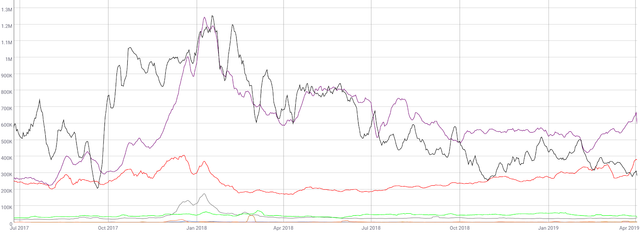
Source: coinmetrics.io
The rise in BTC on-chain transactions per day has been due in large part to VeriBlock (VBK), which secures other blockchains through the "Proof of Proof" (PoP) consensus mechanism. PoP secures networks by embedding the current state of non-BTC blockchains into the BTC blockchain using the OP_RETURN transaction code.
By continually embedding blockchain states into BTC, other blockchains become less vulnerable to 51% attacks. Over the past few months, several coins, including Vertcoin (VTC) and Ethereum Classic (ETC) have been hit by this PoW vulnerability due to declining or consolidating hash rates on the respective networks.
VBK transactions rose dramatically through the testnet period from October 2018 to March 2019. During the testnet period, VBK accounted for as much as 40% of on-chain BTC transactions. VBK's mainnet launched on March 25th, and currently accounts for less than 6% of on-chain BTC transactions. However, VBK transactions account for at least half of all pending transactions currently in the mempool. The majority of these transactions are sent with a one satoshi transaction fee (chart below).

Source: jochen-hoenicke.de/queue/#0,2w
The VBK team includes Maxwell Sanchez, co-inventor of PoP and developer of Curecoin, the latter of which aims to provide idle computing resources to biomedical research. VBK investors and advisors include Jeff Garzik, previously a BTC Core dev and head developer of the failed SegWit2x initiative, and Bill Shihara, co-founder and CEO of the Bittrex exchange. On April 2nd, VBK had an Initial Exchange Offering on Bittrex, reaching the US$7 million funding hard cap in just 10 seconds.
Due to the quickly rising number of on-chain transactions, VBK has been thrust into the Bitcoin community limelight. Some have aired concerns over transaction spamming, while others have described the platform as an outright attack on the Bitcoin network. Questions remain as to whether PoP can restore consensus once a 51% attack occurs. Others have suggested that a blockchain is not needed for PoP, but a service like OpenTimestamps would suffice. Yet another, more insidious purpose of VBK, as suggested by Ambroid, is Bitcoin laundering, whereby VBK miners spend Bitcoin and receive "clean" VBK coins. This process would bypass typical KYC/AML laws almost entirely.
Winners and losers
Coinbase announced a slew of new additions to its platform this quarter with Ripple and Stellar being the most notable. Among high market cap coins, EOS, Cardano, and Tron remain relegated to Coinbase Custody, and are not available for active trading on the platform. Additionally, in what Coinbase described as an attempt to "increase liquidity," trading fees were increased and stop loss market-orders have been disabled in favor of stop loss limit-orders.
Derivative exchange platforms Bitmex and Deribit have continued to gain in popularity among the trading community. Based on open interest and trading volumes, both platforms continue to show strong or record numbers, even in spite of the bear market. Bitmex's insurance fund (shown below), which is used to tackle unfilled liquidation orders before they are taken over by the auto-deleveraging system, continues to grow in size, and now accounts for 0.13% of the Bitcoin circulating supply.
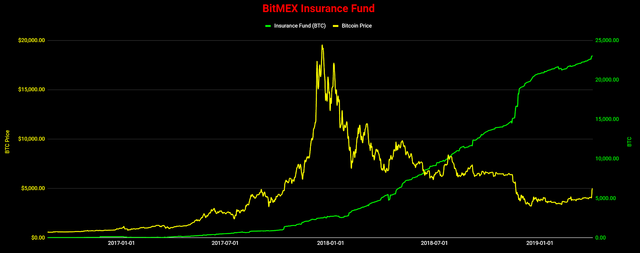
ShapeShift cut 33% of its staff, or 27 employees, in early January after being legally forced to mandate KYC processes on the exchange in 2018. Blockfolio, a popular portfolio viewing tool, cut 10% of its staff, or 4 employees, in mid-January due to declining sales. Nebulas, a community collaboration platform which raised US$60 million in 2018, cut 60% of its staff, or 50 employees in late January. The NEM Foundation announced the restructuring of its 150 person workforce in late January after running low on operational funds. In February, smart contract auditor Hosho cut 80% of its staff, or 30 people, after the ICO boom slowed considerably.
In mid-March, the Korean exchange Bithumb cut 50% of its staff, or 150 people, due to declining trade volumes on the exchange. The exchange was also hacked, for the second time, on March 30th, for approximately US$19 million worth of EOS and Ripple tokens. In late March, Sentinel Chain, a marketplace focused on financial services for the unbanked, cut 60% of its workforce, or 25 people, due to an unsustainable business model. Sentinel Chain raised US$14.4 million in March 2018. Lastly, the Korean exchange Korbit is rumored to be announcing cuts to 30-40% of its staff, due to declining exchange volume.